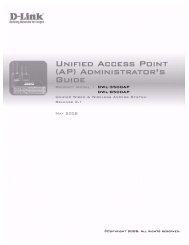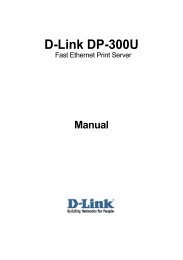Product Manual
Product Manual
Product Manual
Create successful ePaper yourself
Turn your PDF publications into a flip-book with our unique Google optimized e-Paper software.
Glossary<br />
DES-3526 / DES-3526DC Fast Ethernet Layer 2 Switch<br />
1000BASE-LX: A short laser wavelength on multimode fiber optic cable for a maximum length of<br />
550 meters<br />
1000BASE-SX: A long wavelength for a "long haul" fiber optic cable for a maximum length of 10<br />
kilometers<br />
100BASE-FX: 100Mbps Ethernet implementation over fiber.<br />
100BASE-TX: 100Mbps Ethernet implementation over Category 5 and Type 1 Twisted Pair cabling.<br />
10BASE-T: The IEEE 802.3 specification for Ethernet over Unshielded Twisted Pair (UTP) cabling.<br />
aging: The automatic removal of dynamic entries from the Switch Database which have timed-out and<br />
are no longer valid.<br />
ATM: Asynchronous Transfer Mode. A connection oriented transmission protocol based on fixed<br />
length cells (packets). ATM is designed to carry a complete range of user traffic, including voice, data<br />
and video signals.<br />
auto-negotiation: A feature on a port, which allows it to advertise its capabilities for speed, duplex<br />
and flow control. When connected to an end station that also supports auto-negotiation, the link can<br />
self-detect its optimum operating setup.<br />
backbone port: A port which does not learn device addresses, and which receives all frames with an<br />
unknown address. Backbone ports are normally used to connect the Switch to the backbone of your<br />
network. Note that backbone ports were formerly known as designated downlink ports.<br />
backbone: The part of a network used as the primary path for transporting traffic between network<br />
segments.<br />
bandwidth: Information capacity, measured in bits per second that a channel can transmit. The<br />
bandwidth of Ethernet is 10Mbps, the bandwidth of Fast Ethernet is 100Mbps.<br />
baud rate: The switching speed of a line. Also known as line speed between network segments.<br />
BOOTP: The BOOTP protocol allows you to automatically map an IP address to a given MAC<br />
address each time a device is started. In addition, the protocol can assign the subnet mask and default<br />
gateway to a device.<br />
bridge: A device that interconnects local or remote networks no matter what higher-level protocols are<br />
involved. Bridges form a single logical network, centralizing network administration.<br />
broadcast: A message sent to all destination devices on the network.<br />
broadcast storm: Multiple simultaneous broadcasts that typically absorb available network bandwidth<br />
and can cause network failure.<br />
console port: The port on the Switch accepting a terminal or modem connector. It changes the parallel<br />
arrangement of data within computers to the serial form used on data transmission links. This port is<br />
most often used for dedicated local management.<br />
CSMA/CD: Channel access method used by Ethernet and IEEE 802.3 standards in which devices<br />
transmit only after finding the data channel clear for some period of time. When two devices transmit<br />
simultaneously, a collision occurs and the colliding devices delay their retransmissions for a random<br />
amount of time.<br />
data center switching: The point of aggregation within a corporate network where a switch provides<br />
high-performance access to server farms, a high-speed backbone connection and a control point for<br />
network management and security.<br />
Ethernet: A LAN specification developed jointly by Xerox, Intel and Digital Equipment Corporation.<br />
Ethernet networks operate at 10Mbps using CSMA/CD to run over cabling.<br />
Fast Ethernet: 100Mbps technology based on the Ethernet/CD network access method.<br />
Flow Control: (IEEE 802.3z) A means of holding packets back at the transmit port of the connected<br />
end station. Prevents packet loss at a congested switch port.<br />
200

















